lock YAMAHA NMAX 125 2021 User Guide
[x] Cancel search | Manufacturer: YAMAHA, Model Year: 2021, Model line: NMAX 125, Model: YAMAHA NMAX 125 2021Pages: 114, PDF Size: 10.63 MB
Page 50 of 114
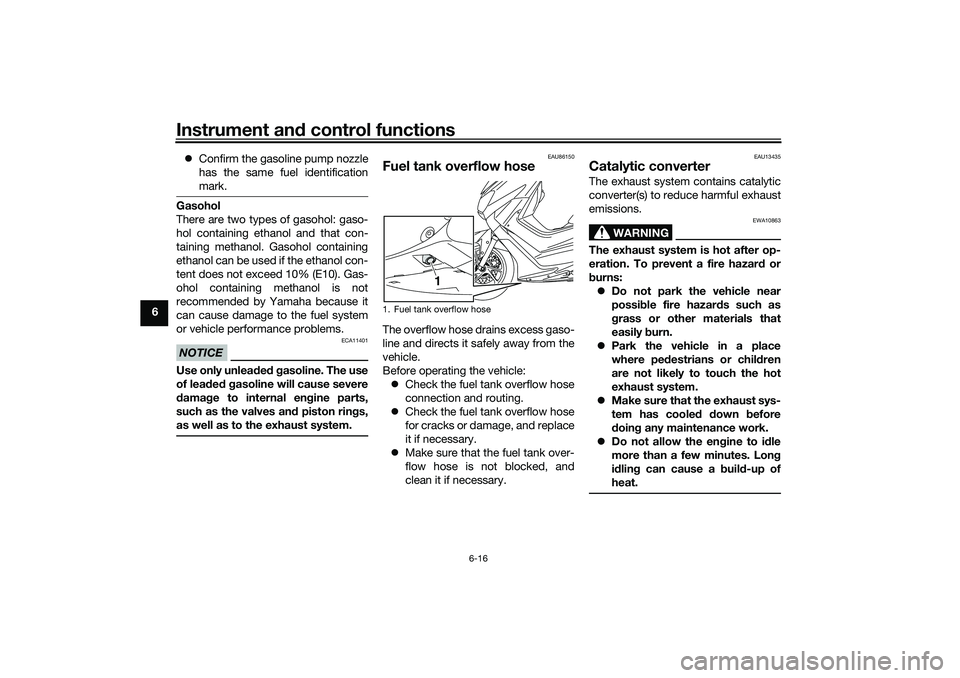
Instrument and control functions
6-16
6Confirm the gasoline pump nozzle
has the same fuel identification
mark.
Gasohol
There are two types of gasohol: gaso-
hol containing ethanol and that con-
taining methanol. Gasohol containing
ethanol can be used if the ethanol con-
tent does not exceed 10% (E10). Gas-
ohol containing methanol is not
recommended by Yamaha because it
can cause damage to the fuel system
or vehicle performance problems.NOTICE
ECA11401
Use only unleaded gasoline. The use
of leaded gasoline will cause severe
damage to internal engine parts,
such as the valves and piston rings,
as well as to the exhaust system.
EAU86150
Fuel tank overflow hoseThe overflow hose drains excess gaso-
line and directs it safely away from the
vehicle.
Before operating the vehicle:
Check the fuel tank overflow hose
connection and routing.
Check the fuel tank overflow hose
for cracks or damage, and replace
it if necessary.
Make sure that the fuel tank over-
flow hose is not blocked, and
clean it if necessary.
EAU13435
Catalytic converterThe exhaust system contains catalytic
converter(s) to reduce harmful exhaust
emissions.
WARNING
EWA10863
The exhaust system is hot after op-
eration. To prevent a fire hazard or
burns:
Do not park the vehicle near
possible fire hazards such as
grass or other materials that
easily burn.
Park the vehicle in a place
where pedestrians or children
are not likely to touch the hot
exhaust system.
Make sure that the exhaust sys-
tem has cooled down before
doing any maintenance work.
Do not allow the engine to idle
more than a few minutes. Long
idling can cause a build-up of
heat.
1. Fuel tank overflow hose
1
UBALE0E0.book Page 16 Wednesday, September 30, 2020 1:37 PM
Page 51 of 114
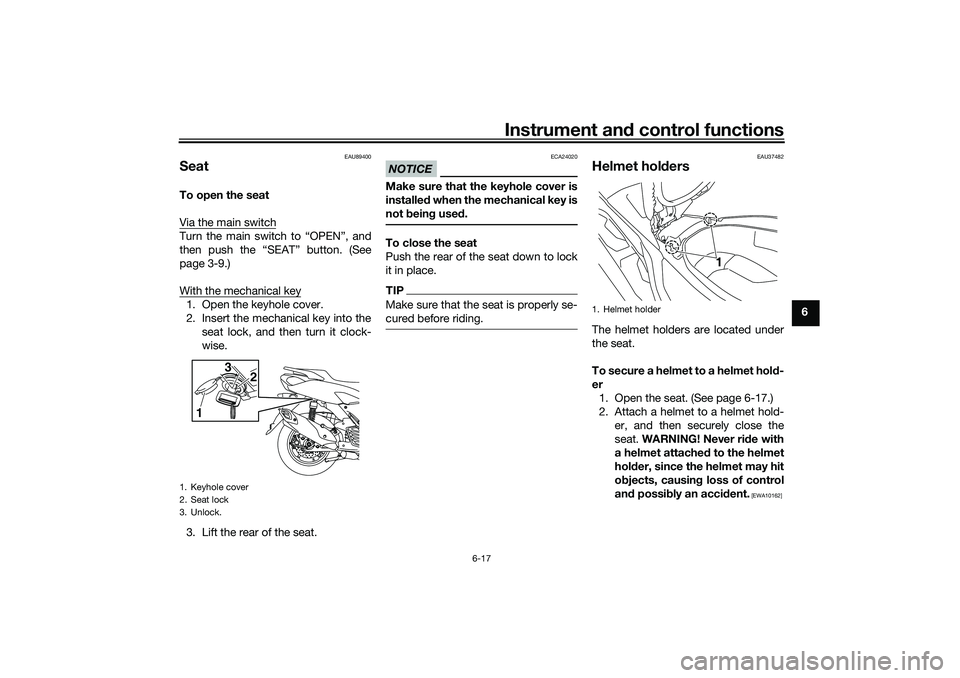
Instrument and control functions
6-17
6
EAU89400
SeatTo open the seat
Via the main switchTurn the main switch to “OPEN”, and
then push the “SEAT” button. (See
page 3-9.)
With the mechanical key1. Open the keyhole cover.
2. Insert the mechanical key into the
seat lock, and then turn it clock-
wise.
3. Lift the rear of the seat.
NOTICE
ECA24020
Make sure that the keyhole cover is
installed when the mechanical key is
not being used.To close the seat
Push the rear of the seat down to lock
it in place.TIPMake sure that the seat is properly se-
cured before riding.
EAU37482
Helmet holdersThe helmet holders are located under
the seat.
To secure a helmet to a helmet hold-
er
1. Open the seat. (See page 6-17.)
2. Attach a helmet to a helmet hold-
er, and then securely close the
seat. WARNING! Never ride with
a helmet attached to the helmet
holder, since the helmet may hit
objects, causing loss of control
and possibly an accident.
[EWA10162]
1. Keyhole cover
2. Seat lock
3. Unlock.
13
2
1. Helmet holder
1
UBALE0E0.book Page 17 Wednesday, September 30, 2020 1:37 PM
Page 52 of 114
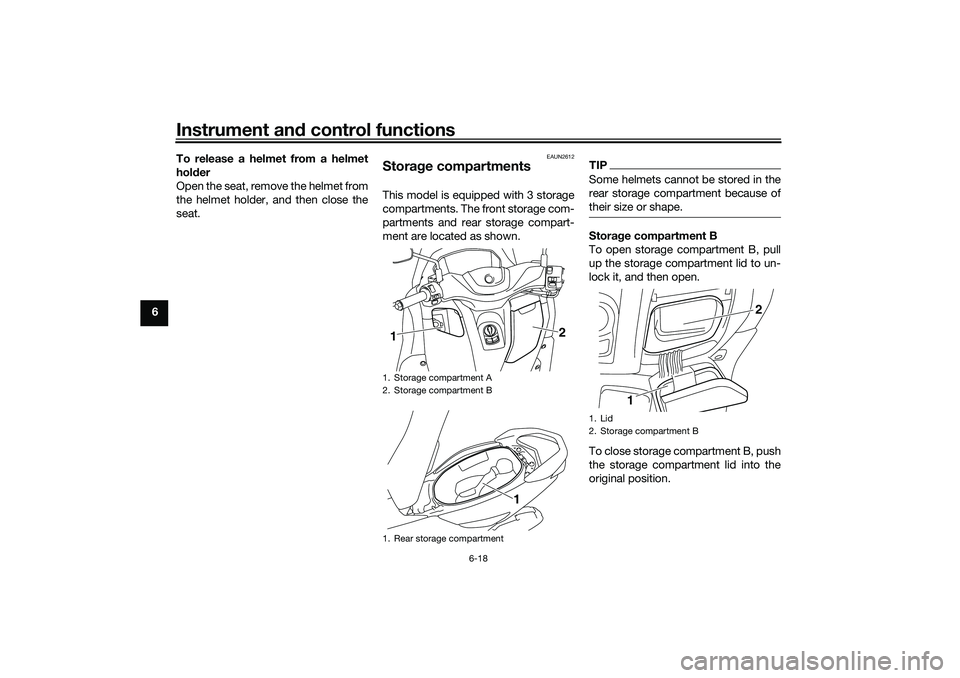
Instrument and control functions
6-18
6To release a helmet from a helmet
holder
Open the seat, remove the helmet from
the helmet holder, and then close the
seat.
EAUN2612
Storage compartmentsThis model is equipped with 3 storage
compartments. The front storage com-
partments and rear storage compart-
ment are located as shown.
TIPSome helmets cannot be stored in the
rear storage compartment because of
their size or shape.Storage compartment B
To open storage compartment B, pull
up the storage compartment lid to un-
lock it, and then open.
To close storage compartment B, push
the storage compartment lid into the
original position.
1. Storage compartment A
2. Storage compartment B
1. Rear storage compartment12
1
1. Lid
2. Storage compartment B
12
UBALE0E0.book Page 18 Wednesday, September 30, 2020 1:37 PM
Page 74 of 114
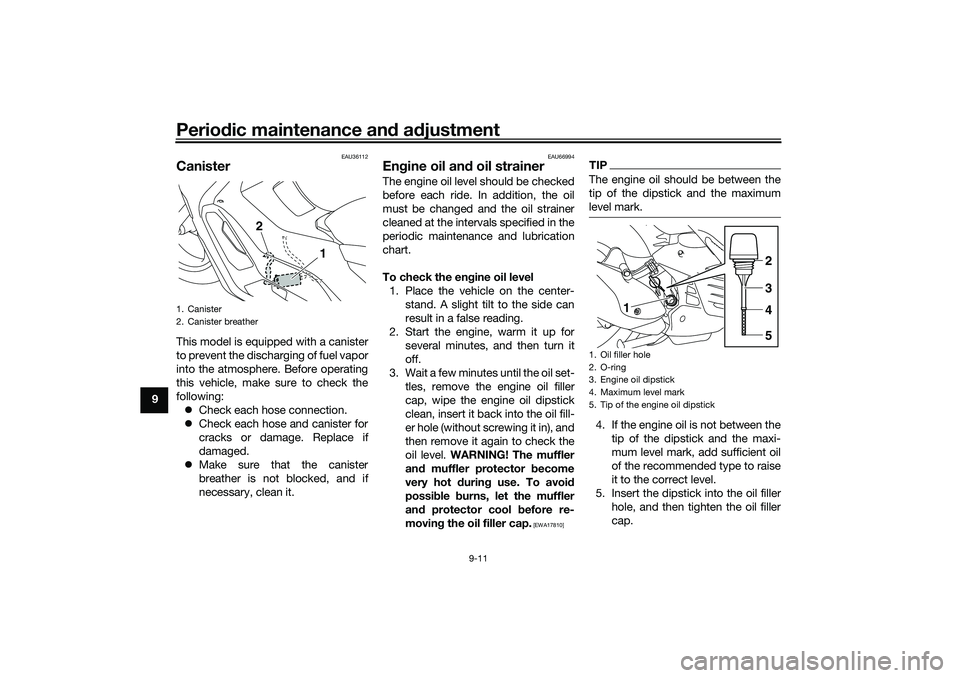
Periodic maintenance and adjustment
9-11
9
EAU36112
CanisterThis model is equipped with a canister
to prevent the discharging of fuel vapor
into the atmosphere. Before operating
this vehicle, make sure to check the
following:
Check each hose connection.
Check each hose and canister for
cracks or damage. Replace if
damaged.
Make sure that the canister
breather is not blocked, and if
necessary, clean it.
EAU66994
Engine oil and oil strainerThe engine oil level should be checked
before each ride. In addition, the oil
must be changed and the oil strainer
cleaned at the intervals specified in the
periodic maintenance and lubrication
chart.
To check the engine oil level
1. Place the vehicle on the center-
stand. A slight tilt to the side can
result in a false reading.
2. Start the engine, warm it up for
several minutes, and then turn it
off.
3. Wait a few minutes until the oil set-
tles, remove the engine oil filler
cap, wipe the engine oil dipstick
clean, insert it back into the oil fill-
er hole (without screwing it in), and
then remove it again to check the
oil level. WARNING! The muffler
and muffler protector become
very hot during use. To avoid
possible burns, let the muffler
and protector cool before re-
moving the oil filler cap.
[EWA17810]
TIPThe engine oil should be between the
tip of the dipstick and the maximum
level mark.4. If the engine oil is not between the
tip of the dipstick and the maxi-
mum level mark, add sufficient oil
of the recommended type to raise
it to the correct level.
5. Insert the dipstick into the oil filler
hole, and then tighten the oil filler
cap.
1. Canister
2. Canister breather
2
1
1. Oil filler hole
2. O-ring
3. Engine oil dipstick
4. Maximum level mark
5. Tip of the engine oil dipstick
3245
1
UBALE0E0.book Page 11 Wednesday, September 30, 2020 1:37 PM
Page 86 of 114
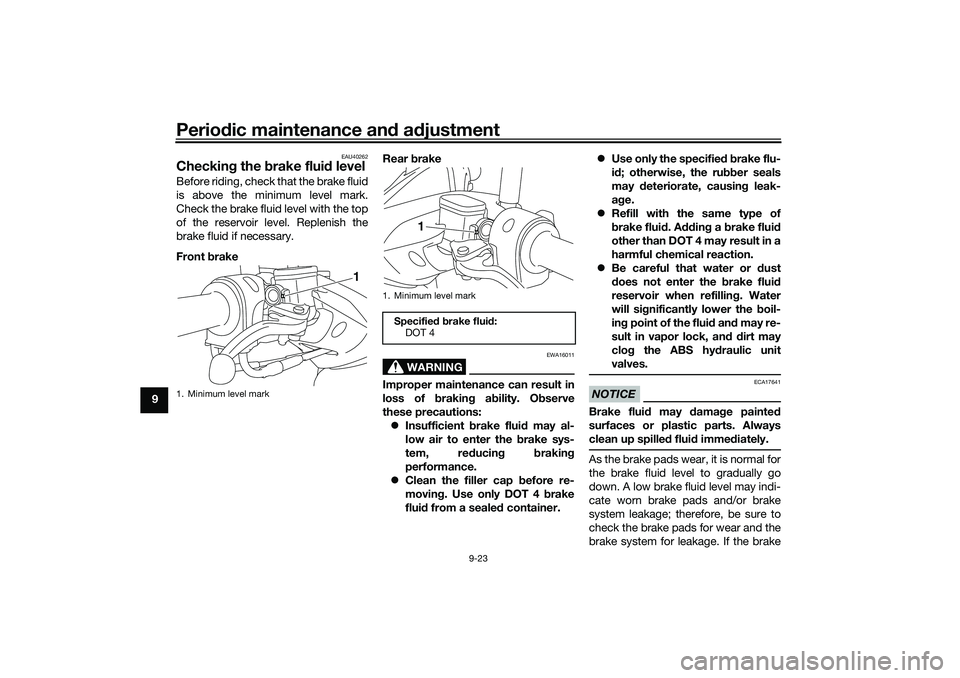
Periodic maintenance and adjustment
9-23
9
EAU40262
Checking the brake fluid levelBefore riding, check that the brake fluid
is above the minimum level mark.
Check the brake fluid level with the top
of the reservoir level. Replenish the
brake fluid if necessary.
Front brakeRear brake
WARNING
EWA16011
Improper maintenance can result in
loss of braking ability. Observe
these precautions:
Insufficient brake fluid may al-
low air to enter the brake sys-
tem, reducing braking
performance.
Clean the filler cap before re-
moving. Use only DOT 4 brake
fluid from a sealed container.Use only the specified brake flu-
id; otherwise, the rubber seals
may deteriorate, causing leak-
age.
Refill with the same type of
brake fluid. Adding a brake fluid
other than DOT 4 may result in a
harmful chemical reaction.
Be careful that water or dust
does not enter the brake fluid
reservoir when refilling. Water
will significantly lower the boil-
ing point of the fluid and may re-
sult in vapor lock, an
d dirt may
clog the ABS hydraulic unit
valves.
NOTICE
ECA17641
Brake fluid may damage painted
surfaces or plastic parts. Always
clean up spilled fluid immediately.As the brake pads wear, it is normal for
the brake fluid level to gradually go
down. A low brake fluid level may indi-
cate worn brake pads and/or brake
system leakage; therefore, be sure to
check the brake pads for wear and the
brake system for leakage. If the brake
1. Minimum level mark
1
1. Minimum level markSpecified brake fluid:
DOT 4
1
UBALE0E0.book Page 23 Wednesday, September 30, 2020 1:37 PM
Page 94 of 114
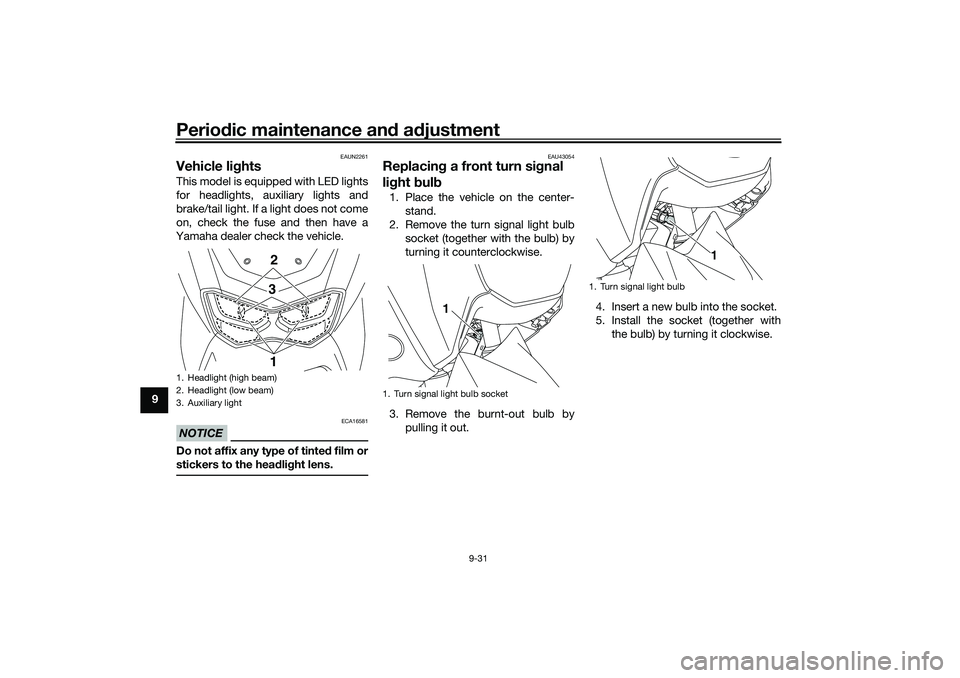
Periodic maintenance and adjustment
9-31
9
EAUN2261
Vehicle lightsThis model is equipped with LED lights
for headlights, auxiliary lights and
brake/tail light. If a light does not come
on, check the fuse and then have a
Yamaha dealer check the vehicle.NOTICE
ECA16581
Do not affix any type of tinted film or
stickers to the headlight lens.
EAU43054
Replacing a front turn signal
light bulb1. Place the vehicle on the center-
stand.
2. Remove the turn signal light bulb
socket (together with the bulb) by
turning it counterclockwise.
3. Remove the burnt-out bulb by
pulling it out.4. Insert a new bulb into the socket.
5. Install the socket (together with
the bulb) by turning it clockwise.
1. Headlight (high beam)
2. Headlight (low beam)
3. Auxiliary light
2
3
1
1. Turn signal light bulb socket
1
1. Turn signal light bulb
1
UBALE0E0.book Page 31 Wednesday, September 30, 2020 1:37 PM
Page 95 of 114
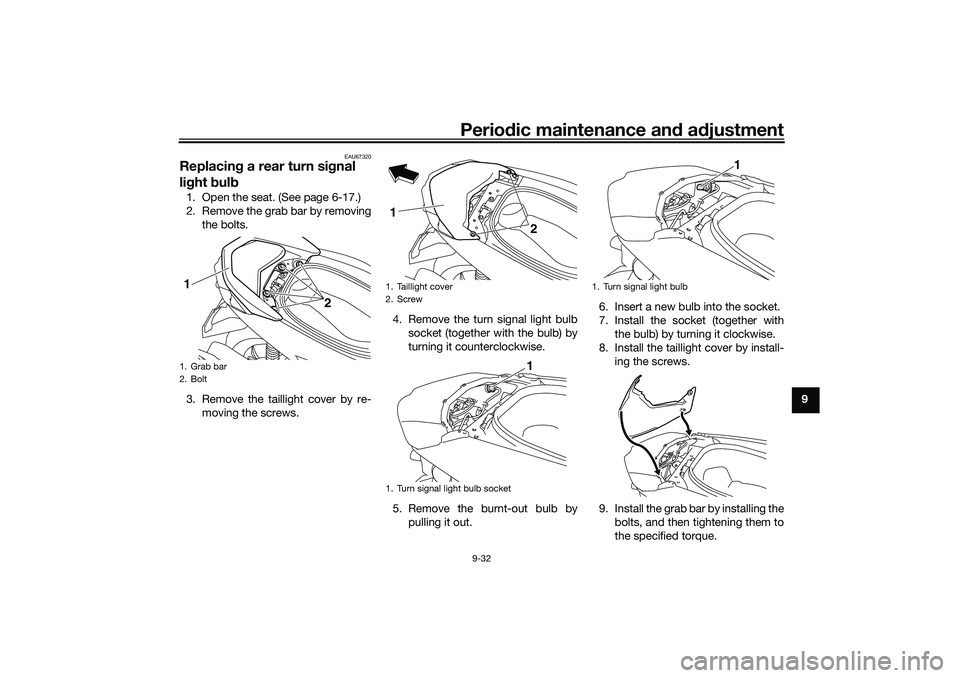
Periodic maintenance and adjustment
9-32
9
EAU67320
Replacing a rear turn signal
light bulb1. Open the seat. (See page 6-17.)
2. Remove the grab bar by removing
the bolts.
3. Remove the taillight cover by re-
moving the screws.4. Remove the turn signal light bulb
socket (together with the bulb) by
turning it counterclockwise.
5. Remove the burnt-out bulb by
pulling it out.6. Insert a new bulb into the socket.
7. Install the socket (together with
the bulb) by turning it clockwise.
8. Install the taillight cover by install-
ing the screws.
9. Install the grab bar by installing the
bolts, and then tightening them to
the specified torque.1. Grab bar
2. Bolt1
2
1. Taillight cover
2. Screw
1. Turn signal light bulb socket1
2
1
1. Turn signal light bulb
1
UBALE0E0.book Page 32 Wednesday, September 30, 2020 1:37 PM
Page 100 of 114
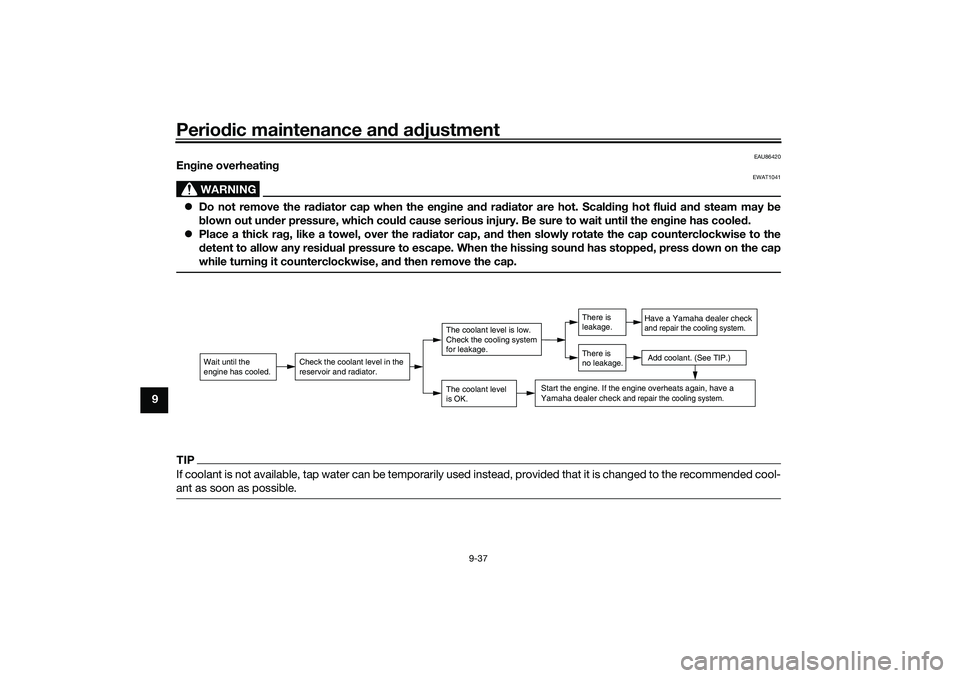
Periodic maintenance and adjustment
9-37
9
EAU86420
Engine overheating
WARNING
EWAT1041
Do not remove the radiator cap when the engine and radiator are hot. Scalding hot fluid and steam may be
blown out under pressure, which could cause serious injury. Be sure to wait until the engine has cooled.
Place a thick rag, like a towel, over the radiator cap, and then slowly rotate the cap counterclockwise to the
detent to allow any residual pressure to escape. When the hissing sound has stopped, press down on the cap
while turning it counterclockwise, and then remove the cap.TIPIf coolant is not available, tap water can be temporarily used instead, provided that it is changed to the recommended cool-
ant as soon as possible.
Wait until the
engine has cooled.
Check the coolant level in the
reservoir and radiator.
The coolant level
is OK.The coolant level is low.
Check the cooling system
for leakage.
Have a Yamaha dealer checkand repair the cooling system.Add coolant. (See TIP.)
Start the engine. If the engine overheats again,
have a
Yamaha dealer check
and repair the cooling system.
There is
leakage.
There is
no leakage.
UBALE0E0.book Page 37 Wednesday, September 30, 2020 1:37 PM
Page 112 of 114
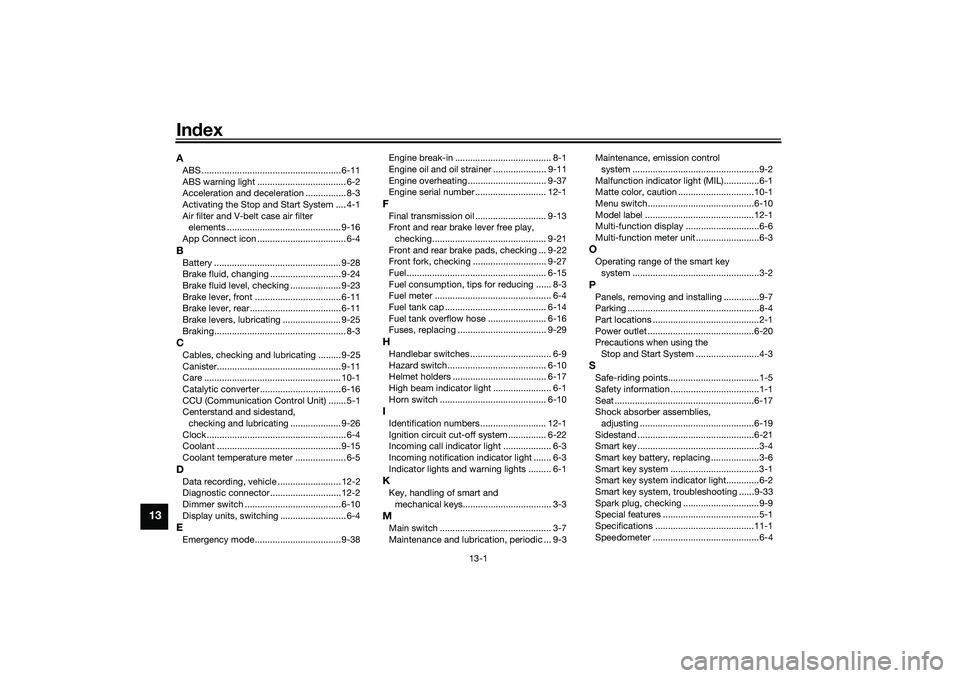
13-1
13
IndexAABS ....................................................... 6-11
ABS warning light ................................... 6-2
Acceleration and deceleration ................ 8-3
Activating the Stop and Start System .... 4-1
Air filter and V-belt case air filter
elements ............................................. 9-16
App Connect icon ................................... 6-4BBattery .................................................. 9-28
Brake fluid, changing ............................ 9-24
Brake fluid level, checking .................... 9-23
Brake lever, front .................................. 6-11
Brake lever, rear.................................... 6-11
Brake levers, lubricating ....................... 9-25
Braking.................................................... 8-3CCables, checking and lubricating ......... 9-25
Canister................................................. 9-11
Care ...................................................... 10-1
Catalytic converter ................................ 6-16
CCU (Communication Control Unit) ....... 5-1
Centerstand and sidestand,
checking and lubricating .................... 9-26
Clock....................................................... 6-4
Coolant ................................................. 9-15
Coolant temperature meter .................... 6-5DData recording, vehicle ......................... 12-2
Diagnostic connector............................ 12-2
Dimmer switch ...................................... 6-10
Display units, switching .......................... 6-4EEmergency mode.................................. 9-38Engine break-in ...................................... 8-1
Engine oil and oil strainer ..................... 9-11
Engine overheating ............................... 9-37
Engine serial number ............................ 12-1
FFinal transmission oil ............................ 9-13
Front and rear brake lever free play,
checking............................................. 9-21
Front and rear brake pads, checking ... 9-22
Front fork, checking ............................. 9-27
Fuel ....................................................... 6-15
Fuel consumption, tips for reducing ...... 8-3
Fuel meter .............................................. 6-4
Fuel tank cap ........................................ 6-14
Fuel tank overflow hose ....................... 6-16
Fuses, replacing ................................... 9-29HHandlebar switches ................................ 6-9
Hazard switch....................................... 6-10
Helmet holders ..................................... 6-17
High beam indicator light ....................... 6-1
Horn switch .......................................... 6-10IIdentification numbers .......................... 12-1
Ignition circuit cut-off system ............... 6-22
Incoming call indicator light ................... 6-3
Incoming notification indicator light ....... 6-3
Indicator lights and warning lights ......... 6-1KKey, handling of smart and
mechanical keys................................... 3-3MMain switch ............................................ 3-7
Maintenance and lubrication, periodic ... 9-3Maintenance, emission control
system ..................................................9-2
Malfunction indicator light (MIL)..............6-1
Matte color, caution ..............................10-1
Menu switch..........................................6-10
Model label ...........................................12-1
Multi-function display .............................6-6
Multi-function meter unit .........................6-3
OOperating range of the smart key
system ..................................................3-2PPanels, removing and installing ..............9-7
Parking ....................................................8-4
Part locations ..........................................2-1
Power outlet ..........................................6-20
Precautions when using the
Stop and Start System .........................4-3SSafe-riding points....................................1-5
Safety information ...................................1-1
Seat .......................................................6-17
Shock absorber assemblies,
adjusting .............................................6-19
Sidestand ..............................................6-21
Smart key ................................................3-4
Smart key battery, replacing ...................3-6
Smart key system ...................................3-1
Smart key system indicator light.............6-2
Smart key system, troubleshooting ......9-33
Spark plug, checking ..............................9-9
Special features ......................................5-1
Specifications .......................................11-1
Speedometer ..........................................6-4
UBALE0E0.book Page 1 Wednesday, September 30, 2020 1:37 PM